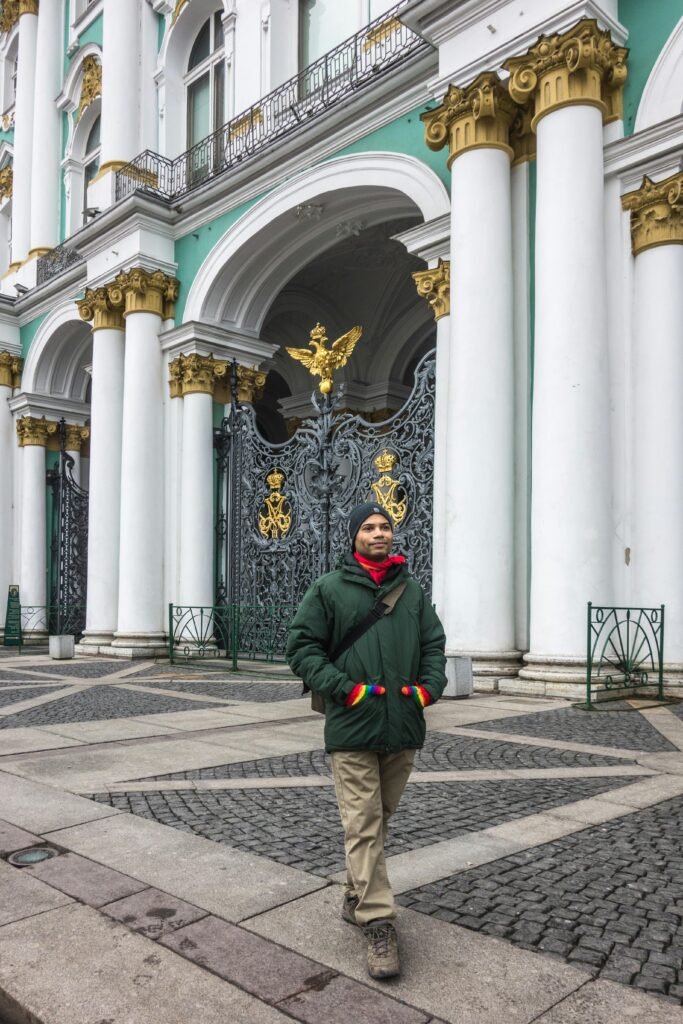Introduction to Russian Culture
Russian culture is a rich tapestry woven from centuries of history, traditions, and diverse influences. It reflects the vast geographical expanse of the nation and the numerous ethnic groups that call Russia home. Understanding Russian culture is crucial for first-time visitors, as it significantly influences social behavior and etiquette. Historically, Russia has been shaped by various significant events, such as the rise and fall of empires, revolutions, and periods of both isolation and engagement with the global community. These historical events have cultivated a deep sense of national pride and resilience that permeates everyday life.

Traditions play a pivotal role in Russian society, encompassing a wide range of practices in areas such as family, cuisine, and art. For instance, many Russians maintain close connections with their family, often living in multi-generational households. Social interactions are typically characterized by warmth and hospitality, often expressed through food and communal gatherings. Traditional Russian cuisine, with its hearty dishes and distinct flavors, reflects the agricultural heritage and regional differences throughout the vast country. Key cultural festivals and holidays, such as Maslenitsa and Victory Day, are celebrated with great enthusiasm, showcasing the vibrant nature of Russian traditions.
Central to Russian social etiquette is the concept of respect. This is often demonstrated through greetings, gift-giving, and expressions of gratitude. First-time visitors should be mindful of these social norms to avoid unintended offenses. Understanding the nuances of Russian culture not only aids in navigating social interactions but also enriches the overall travel experience. By familiarizing themselves with the do’s and don’ts of cultural etiquette, visitors can foster positive connections and deepen their appreciation for the multifaceted nature of Russian society.
Understanding Social Hierarchy
The social structure in Russia is characterized by a hierarchical system rooted deeply in the country’s history and culture. This hierarchy influences many aspects of daily life, including personal interactions, professional relations, and social gatherings. Understanding these complex dynamics is crucial for first-time visitors who wish to engage positively with locals.
In Russian society, age plays a significant role in determining social dynamics. Older individuals are generally accorded more respect, and their opinions hold considerable weight. When addressing someone older, it is customary to use formal greetings and titles to acknowledge their status. This practice not only reflects respect but also aligns with the cultural norms that prioritize seniority. Visitors should be aware that younger individuals may defer to their elders in discussions or decision-making processes; thus, recognizing this age-related hierarchy can foster a better understanding during interactions.

Status and profession are equally significant within the Russian social framework. Individuals in high-ranking positions or those with prestigious careers are often treated with deference. Visitors should exercise caution and professionalism when addressing people within such spheres. Being aware of someone’s title, occupation, or background can serve as a valuable tool in navigating conversations and establishing rapport. Engaging with locals while respecting these hierarchical distinctions can lead to more meaningful exchanges and a deeper connection with the culture.
Gender also plays a critical role in social interactions in Russia. While modern society is evolving, traditional views may still influence how men and women communicate. Men are often expected to take the lead in conversations or social dynamics, but this should be approached with sensitivity to avoid reinforcing stereotypes. Respecting these cultural norms while remaining authentic in interactions can enhance a visitor’s experience and help build positive relationships.
Greeting Etiquette
Understanding the greeting etiquette in Russia is essential for first-time visitors who wish to make a favorable impression. The most common way to greet someone is through a firm handshake. This gesture is considered a sign of confidence and respect. Men typically initiate the handshake, while women may choose to extend their hand first, although it is not uncommon for men and women to share a handshake as well. It’s important to maintain eye contact during the handshake to convey sincerity and attentiveness.
In addition to the handshake, the use of titles and patronymics is crucial in Russian culture. When addressing someone, it is customary to use their first name followed by their patronymic. The patronymic is derived from the father’s name, with specific suffixes added to indicate “son of” or “daughter of.” For example, if a man named Ivan has a father named Alexei, he would be referred to as Ivan Alexeyevich. Failing to use these titles may come across as disrespectful or overly familiar, especially in formal settings.
First-time visitors should also be mindful of common greeting mistakes. For instance, using a casual greeting like “hi” or “hey” can be deemed inappropriate, especially in interaction with someone of higher status or an elder. Additionally, avoid addressing individuals solely by their first names until invited to do so, as this can be seen as overly familiar. Moreover, offering a soft handshake or failing to look someone in the eye might be interpreted as a lack of confidence or even disinterest.
Being cognizant of these greeting customs can significantly enhance interactions in Russia, fostering respect and building positive relationships from the very first encounter.
Dining Etiquette and Table Manners
Dining etiquette in Russia plays a significant role in the fabric of social interactions and cultural expressions. A meal is not just sustenance; it encompasses a rich tradition of hospitality, respect, and fellowship. When dining with Russians, it is vital to be aware of certain customs to enhance the experience and show appreciation for the cultural nuances.
Typically, meals consist of multiple courses, starting with appetizers such as herring under a fur coat or various pickles, followed by soups, main dishes, and concluding with sweet desserts. It is common for meals to be accompanied by vodka, which is traditionally consumed in toasts that honor guests and commemorate events. When invited to a Russian home, understanding that food sharing symbolizes trust and friendship is essential, as hosts often prepare generously. Hence, it is courteous to try various dishes offered, as refusal may be interpreted as disrespectful.
At the dining table, certain behaviors are expected. It is customary to wait for the host to invite everyone to begin the meal, and one should refrain from starting to eat until all guests are seated and served. As a gesture of goodwill, it is advisable to bring a gift—flowers or sweets are popular choices, while avoidance of sharp items such as knives is appreciated, as they symbolize cutting relationships. During the meal, using utensils correctly is essential; the fork generally remains in the left hand while the knife is held in the right.
To show appreciation for the meal, compliments to the host about the food are encouraged. Additionally, maintain a conversational tone, as engaging in light-hearted discussions enhances camaraderie. In conclusion, proper dining etiquette not only enhances the meal but also acknowledges the importance of tradition and respect in Russian culture, fostering connections between all participants.
Appropriate Dress and Grooming
Personal appearance holds considerable significance in Russian culture, often reflecting an individual’s respect for the occasion and those present. Therefore, understanding the nuances of appropriate dress and grooming is essential for first-time visitors to Russia. Whether attending casual gatherings, formal events, or business settings, adhering to local customs can positively influence impressions and interactions.

When attending casual gatherings, such as a dinner with friends or a casual outing, it is advisable to dress neatly but comfortably. Men may opt for well-fitted jeans or trousers paired with a collared shirt, while women can choose a chic dress or a smart combination of trousers and a stylish top. Although casual, it is important to avoid overly casual attire such as sweatpants or flip-flops, as these may be viewed as disrespectful.
For formal events, such as weddings or cultural celebrations, the dress code becomes more stringent. Men typically wear suits, and women are expected to don elegant dresses, often accompanied by tasteful accessories. It is customary for women to wear heels, while men should pay close attention to their footwear’s polish. Such attention to detail shows appreciation for the event and its hosts.
In business settings, professionalism reigns supreme. Suits are standard for men, ideally in darker colors, complemented by a polished dress shirt. Women should opt for tailored dresses or skirts paired with blouses, ensuring an image of competence and sophistication. Grooming plays a pivotal role as well; maintaining a clean and well-groomed appearance can significantly impact professional relationships in Russia.
Overall, understanding these dress and grooming guidelines can help first-time visitors navigate social situations and foster a respectful connection with Russian culture, enhancing their overall experience.
Communication Styles: Verbal and Non-Verbal
In Russia, understanding communication styles is integral to fostering positive interactions. Both verbal and non-verbal cues play a significant role in how messages are conveyed and received. A hallmark of Russian communication is the importance of maintaining eye contact during conversations. This practice reflects attentiveness and respect, signifying that one is engaged and genuinely interested in the discussion. However, prolonged eye contact may be interpreted differently in some contexts, so understanding the dynamics of each situation is essential.
When it comes to verbal communication, directness is often valued. Russians typically appreciate straightforwardness, and ambiguous language may lead to misunderstandings. As a visitor, it is advisable to express your thoughts clearly and honestly while also being mindful of the tone and context. The nuances in conversational tone can suggest various emotions; for instance, a serious, steady tone might indicate gravity, while a lighter tone may convey warmth or friendliness.
Non-verbal communication in Russia is equally important. For example, hand gestures can enhance or detract from the spoken word. Unlike in some cultures, gestures such as a thumbs-up may be viewed positively, while others may carry negative connotations. Body language, including posture and facial expressions, can also convey vital information about a person’s feelings and intentions. Therefore, interpreting these signals correctly is essential for meaningful interactions.
In social settings, it is customary to maintain a stable posture and avoid overly casual gestures, as these could be seen as disrespectful. Overall, being aware of both verbal and non-verbal communication styles can significantly enhance a first-time visitor’s experience in Russia, fostering better relationships and understanding with locals.
Gift Giving: What to Know
Gift giving is a cherished custom in Russian culture, and understanding the intricacies involved can significantly enhance the experience for first-time visitors. The act of giving a gift goes beyond the tangible item; it reflects the relationship between the giver and the receiver. Therefore, it is essential to consider the occasion and the preferences of the recipient when selecting a gift.
When invited to someone’s home, it is customary to bring a small gift as a token of appreciation. Common choices include flowers, sweets, or a quality bottle of wine. Notably, if you choose to bring flowers, it is advisable to present an odd number as even numbers are associated with funerals. Similarly, consider opting for chocolates or pastries in aesthetically pleasing packaging; the presentation of a gift carries as much importance as the gift itself in Russian culture.
There are certain items you should avoid when giving gifts. Clocks, for example, are often viewed as foretelling an end, implying that time is running out. Additionally, sharp objects like knives can symbolize severed relationships. It is also best to steer clear of personal items such as perfume unless you are well-acquainted with the recipient’s preferences. When presenting a gift, do so with both hands or with one hand while supporting the other with the elbow to signify respect.
Understanding these cultural nuances regarding gift giving can greatly enhance your interactions in Russia. By selecting an appropriate gift and paying careful attention to its presentation, you not only honor the customs of the host culture but also create a lasting positive impression. As you navigate these practices, you will find that gift giving is a meaningful way to connect with others in Russian society.
Navigating Public Behavior

Understanding the nuances of public behavior in Russia is essential for first-time visitors wishing to integrate smoothly into the cultural landscape. One critical factor to consider is the expected noise level in various settings. In public spaces such as transportation, parks, or even cafes, maintaining a moderate volume is imperative. Loud conversations or boisterous laughter can be seen as disrespectful and may draw disapproving glances from locals. It is preferable to communicate in a more subdued manner, aligning with the general demeanor of the people around you.
Another key aspect of public behavior involves the concept of personal space. In Russia, the personal bubble is somewhat different compared to many Western cultures. While in close conversations, it is acceptable to stand closer to the person you are speaking with, even if this arrangement may feel intrusive to some. However, it is important to be mindful of individual reactions; some may prefer more distance, and sensitivity to these preferences will enhance interactions.
Interactions with strangers also require a subtle approach in public spaces. In Russian culture, it is not standard practice to strike up conversations with unknown individuals. Rather, interactions are often limited to brief exchanges, such as polite greetings or acknowledgments. This preference for privacy means that engaging in small talk might not elicit the warm responses one might expect in more open cultures. Therefore, gauging the comfort level of those around you will be crucial for ensuring positive and respectful exchanges.
When using public transportation or visiting parks, keeping an unobtrusive profile is advisable. It is often considered polite to offer seats to those who may require them, such as the elderly or individuals with disabilities. Additionally, maintaining a neat appearance and presenting oneself well is appreciated in Russian society. Understanding and adapting to these behavioral norms will significantly enhance your experience as you navigate the intricacies of public life in Russia.
Common Misconceptions and Cultural Sensitivities
Visiting Russia can be a remarkable experience; however, it is essential for first-time visitors to navigate cultural sensitivities and avoid common misconceptions. One prevalent misunderstanding is the belief that all Russians are unfriendly or aloof. In reality, once you engage with locals, you may find them to be welcoming and warm, showcasing genuine hospitality. Recognizing this can enhance social interactions and foster a deeper appreciation for Russian culture.
Another common misconception is regarding the Russian language. Many assume that Russians will speak English widely, particularly in urban areas. While younger generations and professionals may communicate in English, it is courteous to learn a few basic phrases in Russian. This effort not only displays respect for the culture but also aids in building rapport with locals. Additionally, mastering essential greetings can help bridge any potential language gap.
When approaching conversations, it is vital to be sensitive to historical or political topics that may evoke strong emotions. Discussions surrounding the Soviet era, politics, and international relations can be polarizing subjects. Visitors should approach such topics with caution, prioritizing respect and tact. If these subjects do arise, listening attentively and remaining neutral will foster more meaningful dialogues.
Moreover, customs regarding personal space and greetings differ significantly across cultures. Russians tend to have a closer personal space preference and often greet each other with firm handshakes or even hugs among friends. It is advisable to follow the lead of your Russian counterparts in these situations to ensure comfort and respect.
Ultimately, understanding these common misconceptions and cultural sensitivities is key to navigating social situations in Russia gracefully. Demonstrating awareness and respect for local customs will enhance your travel experience, leading to insightful interactions and memorable encounters.



